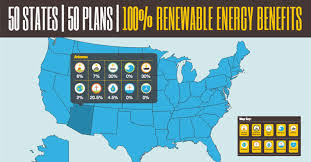by Rona Fried
Yet more research shows how the US can achieve 100% renewable energy by 2050, this time from Stanford University.
The Solutions Project has developed models for every state and the US as a whole.
Take California
For California, 55.5% of all energy would come from solar, 35% from wind and the rest from hydroelectric, geothermal, tidal and wave energy.
For 100% electricity, here what would be needed:
- 25,000 onshore 5-megawatt (MW) wind turbines
- 1200, 100 MW concentrating solar plants
- 15 million, 5-kilowatt residential solar PV rooftop systems
- 72, 100 MW geothermal plants
- 5000, 0.75 MW wave devices
- 3400 1 MW tidal turbines
For heating, fossil fuels would be replaced by electric/geothermal powered heat pumps and heat exchangers; solar-powered hot water; and high temperature industrial processes would run on electricity and hydrogen combustion. Vehicles would be either electric or fuel cell propelled.
This infrastructure would consume 0.9% of California’s land, mostly for solar plants.
Published in the Energy, it shows that converting California’s energy infrastructure is both technically and economically feasible and that it would result in a sustainable, inexpensive and reliable energy supply … while creating hundreds of thousands of jobs and saving billions of dollars in pollution-related health costs.
It would “eliminate air pollution mortality and global warming emissions from California, stabilize prices and create jobs – there is little downside,” says lead author Mark Jacobson, professor of civil and environmental engineering, and Director of Stanford’s Atmosphere/Energy Program.
While there’s an initial cost for upfront infrastructure investments (which are rapidly dropping), they are more than repaid by eliminating fuel costs. Energy demand would decline by about 44% and energy prices would stabilize.
After job losses in fossil fuel and nuclear-related industries are accounted for, there would still be a net gain of 220,000 jobs in California.
And it would save over $100 billion a year on health care costs – almost 5% of California’s 2012 gross domestic product – while cutting $48 billion a year in damage from extreme weather.
Mark Jacobson is a prolific researcher. Over the past five years, his studies show:
- cutting black carbon emissions is the key to saving the Arctic ice cap
- offshore wind can power the entire East Coast and protect cities from hurricanes
- For every 1 degree Celsius of global warming, 1000 more people will die in the US from respiratory illness and asthma – the first study connecting health effects with climate change.
All US States
Each report Jacobson produces drills down to every detail – exactly how many devices are needed; their footprint and spacing area; costs; numbers of jobs, air pollution and climate benefits; and policies necessary for each state.

For the US as a whole, all new energy sources could be renewable by 2020, about 80-85% of existing energy replaced by 2030, and 100% replaced by 2050.
Doing this would create about 5 million construction jobs and 2.4 million operations jobs for energy facilities alone, while eliminating roughly 62,000 premature deaths a year and avoiding $510 billion a year in heath care costs.
He doesn’t stop with the US, of course. Renewable energy can also power the world, with wind providing half the energy by 2030, solar providing 40%, and geothermal and marine energy, 10%.
Why does he cross nuclear, biomass, natural gas and coal with carbon capture and storage, off the list?
“If we have a limited amount of money to spend, we want to spend it on the best technologies, not ones that are mediocre,” he said at his presentation for the American Association for the Advancement of Science.
Numerous studies show the US and the world can transition completely to renewable energy by 2050: Civil Society Institute; Greenpeace and the European Renewable Energy Council; and the US National Renewable Energy Lab.
Here’s the plan for all 50 states and check out The Solutions Project, where you can click on each state:
